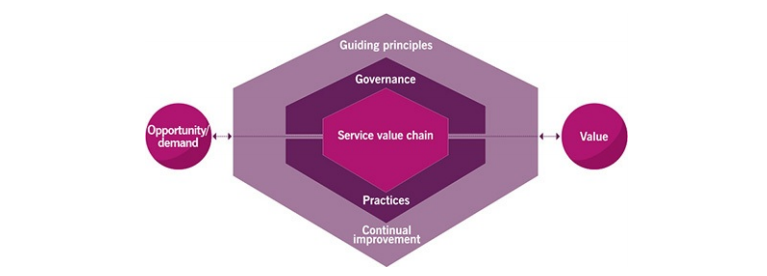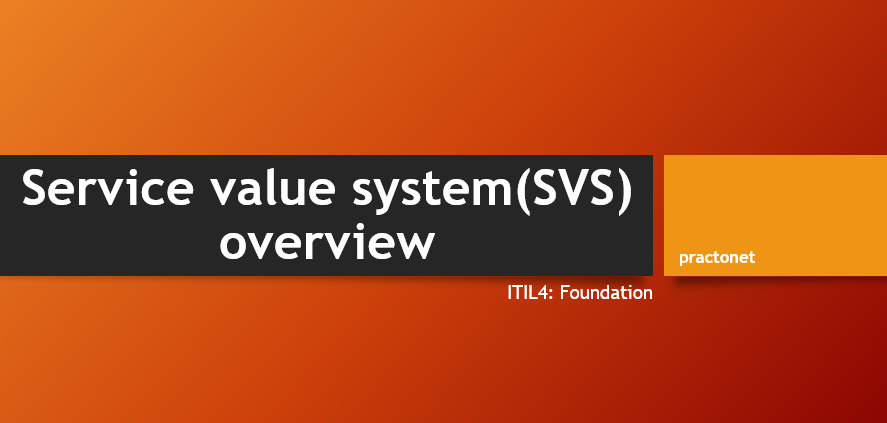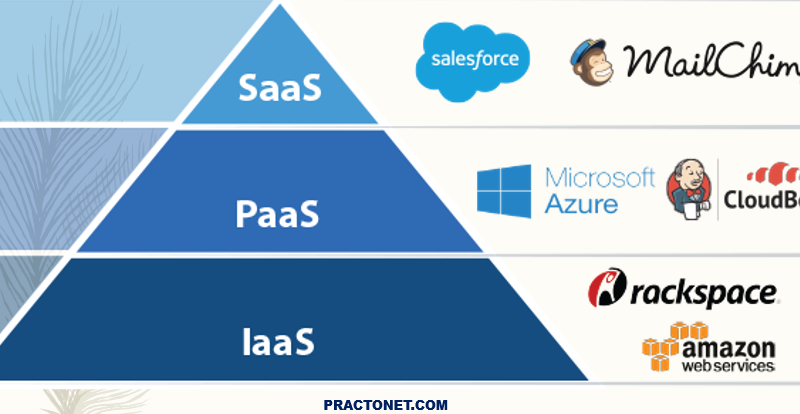For service management to function properly, it needs to work as a system. The ITIL SVS describes the inputs to this system (opportunity and demand), the elements of this system (organizational governance, service management, continual improvement, and the organization’s capabilities and resources), and the outputs (achievement of organizational objectives and value for the organization, its customers, and other stakeholders).
The key inputs to the SVS are opportunity and demand. Opportunities represent options or possibilities to add value for stakeholders or otherwise improve the organization. Demand is the need or desire for products and services among internal and external consumers. The outcome of the SVS is value, that is, the perceived benefits, usefulness, and importance of something. The ITIL SVS can enable the creation of many different types of value for a wide group of stakeholders.
The ITIL SVS includes the following components:
- Guiding principles Recommendations that can guide an organization in all circumstances, regardless of changes in its goals, strategies, type of work, or management structure.
- Governance The means by which an organization is directed and controlled.
- Service value chain A set of interconnected activities that an organization performs to deliver a valuable product or service to its consumers and to facilitate value realization.
- Practices Sets of organizational resources designed for performing work or accomplishing an objective.
- Continual improvement A recurring organizational activity performed at all levels to ensure that an organization’s performance continually meets stakeholders’ expectations. ITIL 4 supports continual improvement with the ITIL continual improvement model.
The purpose of the SVS is to ensure that the organization continually co-creates value with all stakeholders through the use and management of products and services. The structure of the SVS is shown in diagram, The left side of the diagram shows opportunity and demand feeding into the SVS from both internal and external sources. The right side shows value created for the organization, its customers, and other stakeholders.

The ITIL SVS describes how all the components and activities of the organization work together as a system to enable value creation. These components and activities, together with the organization’s resources, can be configured and reconfigured in multiple combinations in a flexible way as circumstances change, but this requires the integration and coordination of activities, practices, teams, authorities and responsibilities, and all parties to be truly effective. One of the biggest challenges an organization can face when trying to work effectively and efficiently with a shared vision, or to become more Agile and resilient, is the presence of organizational silos. Organizational silos can form in many ways and for many different reasons. Silos can be resistant to change and can prevent easy access to the information and specialized expertise that exists across the organization, which can in turn reduce efficiency and increase both cost and risk. Silos also make it more difficult for communication or collaboration to occur across different groups.
A siloed organization cannot act quickly to take advantage of opportunities or to optimize the use of resources across the organization. It is often unable to make effective decisions about changes, due to limited visibility and many hidden agendas. Practices can also become silos. Many organizations have implemented practices such as organizational change management or incident management without clear interfaces with other practices. All practices should have multiple interfaces with one another. The exchange of information between practices should be triggered at key points in the workflow, and is essential to the proper functioning of the organization.
The architecture of the ITIL SVS specifically enables flexibility and discourages siloed working. The service value chain activities and the practices in the SVS do not form a fixed, rigid structure. Rather, they can be combined in multiple value streams to address the needs of the organization in a variety of scenarios. This publication provides examples of service value streams, but none of them are definite or prescriptive. Organizations should be able to define and redefine their value streams in a flexible, yet safe and efficient manner. This requires continual improvement activity to be carried out at all levels of the organization; the ITIL continual improvement model helps to structure this activity. Finally, the continual improvement and overall operation of an organization are shaped by the ITIL guiding principles. The guiding principles create a foundation for a shared culture across the organization, thus supporting collaboration and cooperation within and between the teams, and removing the need for constraints and controls previously provided by silos.
An organization can take any number of forms, including, but not limited to, sole trader, company, corporation, firm, enterprise, authority, partnership, charity or institution, or any part or combination thereof, whether incorporated or not, and be either public or private. This means that the scope of the SVS can be a whole organization or a smaller subset of that organization. To achieve the maximum value from the SVS and to properly address the issue of organizational silos, it is preferable to include the whole organization in the scope rather than a subset.





